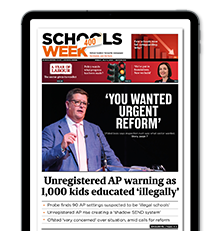School exclusion rates have risen back to pre-pandemic levels, figures suggest, with the number of suspensions soaring again from last year’s record-breaking numbers.
The Department for Education has today published exclusion and suspension statistics for the 2022-23 autumn term.
Full year statistics are not published until later in the year. But the data shows a continued rise in both areas compared to the same term before Covid.
Exclusion rate returns to pre-Covid levels
There were 3,100 permanent exclusions in last year’s autumn term – a rate of 0.04, which is equivalent to four per every 10,000 pupils – the same as the pre-pandemic 2019-20 autumn term.
Eighty-six per cent of permanent exclusions were in secondary schools, which had an exclusion rate of 0.07 – slightly below the pre-pandemic 0.08.
Exclusions are way up from the autumn term in 2021-22, however exclusions fell heavily during Covid and have been slowly increasing since.

A Schools Week investigation in September found excluded children in a third of areas were stuck on waiting lists for specialist provision as exclusions appeared to be rising faster than councils could keep up with.
Full exclusion data for last year from a snapshot of 22 councils that responded to our freedom of information request showed they were 50 per cent higher than in 2018-19.
The DfE will not publish the full-year figures for last year until July.
Persistent disruptive behaviour was the main reason for exclusions (making up 49 per cent) followed by physical assault against a pupil (23 per cent).
… and record-high suspensions keep rising
There were 247,400 suspensions in the autumn term last year (a rate of 2.96), up from the 178,400 (2.17) in pre-pandemic 2019.
Suspensions are typically higher in the autumn term than in spring and summer, but this amounts to a 39 per cent increase.
Prior to the pandemic, suspension rates had been increasing gradually.

The suspension rate in the autumn term last year for secondary schools was 5.9 – which equates to one in 17 pupils – compared to 4.19 in the autumn term of 2019-20. But the rate in primary schools over the same period has fallen.
Last year’s full suspension figures showed the highest rate since at least 2006.
Almost half of suspensions were for one day or less. As with exclusions, persistent disruptive behaviour was the most common reason (55 per cent), followed by verbal abuse or threatening behaviour against an adult (20 per cent).
North east has most kids excluded
Both the highest suspension and permanent exclusions rates are in the north east (at 4.65 and 0.06 respectively).
The lowest suspension rate was in outer London (1.47) and the lowest permanent exclusion rate was in inner London (0.01).
The suspension rate for free school meal pupils was more than four times that for their peers.
















Well clearly this system does not work. For me this just means we are failing children as parents and as professionals.